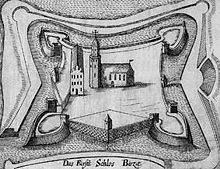| Revision as of 06:14, 24 June 2009 editJacurek (talk | contribs)9,609 edits Undid revision 298260247 by Dr. Dan (talk) - sorry Dr. Dan but I %100 disagree with you and we already discussed that so many times.← Previous edit | Revision as of 20:55, 25 June 2009 edit undoLokyz (talk | contribs)Autopatrolled, Extended confirmed users, Pending changes reviewers15,449 edits what's the "Polish" etymology of the name?Next edit → | ||
| Line 35: | Line 35: | ||
| }} | }} | ||
| '''Biržai''' ({{pronunciation|Birzai.ogg |
'''Biržai''' ({{pronunciation|Birzai.ogg}}) is a ] in northern ]. Biržai is famous for its reconstructed ] ], and the whole region is renowned for its many traditional-recipe ] breweries. | ||
| ==History== | ==History== | ||
Revision as of 20:55, 25 June 2009
Town in Aukštaitija, Lithuania| Biržai | |
|---|---|
| Town | |
 Coat of arms Coat of arms | |
| Country | |
| Ethnographic region | Aukštaitija |
| County | Panevėžys County |
| Municipality | Biržai district municipality |
| Eldership | Biržai city eldership |
| Capital of | Biržai district municipality Biržai city eldership Širvėna eldership |
| First mentioned | 1455 |
| Granted city rights | 1589 |
| Population | |
| • Total | 15,262 |
| Time zone | UTC+2 (EET) |
| • Summer (DST) | UTC+3 (EEST) |
| Website | http://www.birzai.lt/ |
Biržai (pronunciation) is a city in northern Lithuania. Biržai is famous for its reconstructed Biržai Castle manor, and the whole region is renowned for its many traditional-recipe beer breweries.
History

Jerzy Radziwiłł was the first noble to settle in the town. Later, after his daughter, Barbara Radziwiłł married the Grand Duke of Lithuania and King of Poland Sigismund II Augustus in 1547, the power and influence of the Radziwiłł family grew immensely. In 1586-1589, the Radvila family built a fortified castle in Biržai. In 1575, preparing for this construction, a dam was built on the Agluona and Apaščia Rivers at their confluence, and the artificial Lake Širvėna, covering about 40 km (15 sq mi), was created. It is the oldest surviving artificial lake in Lithuania. The Radvila family also established a Protestant church and school. The city became a cultural center of the Protestant Reformation in Lithuania.

During the Wars with Sweden, Biržai Castle was an important point of defence. In 1625, Gustavus Adolphus, king of Sweden, attacked the castle with 8000 soldiers and it was forced to surrender. The castle was left in ruins and was rebuilt, only to be burnt in 1655. In 1662-1669, it was rebuilt again in Renaissance style. In 1701, August II the Strong and Peter I of Russia signed a pact in the castle to unite their forces against Sweden. However, in 1704 the castle was completely destroyed and was left in ruins until its restoration in the 1990s.

The town's population suffered greatly due to wars and religious conflicts between the Protestants and Catholics. In the late 18th century, Biržai lost its city rights. The Radziwiłłs lost their wealth and influence, and Biržai was sold to the Tyszkiewicz family to cover debts in 1811. In 1849-1862, the Tyszkiewicz family built a neoclassic Astravas Manor palace across the lake from the site of the original castle.
In 1869, the town had about 2600 residents. Thirty years later, the population grew to 4400 people.
Town was almost completely burned down during World War II.
In 1968, the population reached 10000. Currently, there are about 15,000 people living in Biržai.
Geography

The northern part of the city, along with Lake Širvėna, lies within Biržai Regional Park. About 9,000 sinkholes have been identified in the park, formed abruptly after gypsum in the soil has been dissolved by underground water. Some of these holes are dry, while others have become small ponds or lakes filled with water from the many underground rivers and streams. New holes appear annually. According to local legend, the 20-meter-deep sinkhole known as Karves uola (Cow's Hole) was discovered by a farmer after his cow disappeared. A tunnel at its bottom leads to an underground cave and lake.
Famous people
- Jerzy Radziwiłł, Great Hetman of Lithuania
- Janusz Skumin Tyszkiewicz
- Julius Janonis, poet
- Kazys Binkis, poet, playwright
- Petras Kalpokas, painter
- Austra Skujytė, olympic silver medal winner
- Žydrūnas Savickas, strongman
- Vladas Garastas, basketball coach
- Romualdas Brazauskas, basketball referee
- Jokūbas Šernas, signatory of the Act of Independence of Lithuania
- Jonas Mekas, film maker
Footnotes
- "PROJECT ENVIRONMENT". European Commission. Retrieved 2009-06-16.
- "A visit to holey ground". Baltic Times. Retrieved 2009-06-19.
References
- Official website of Biržai district municipality
- Historical map of Lithuania by Jean Baptiste Bourguignon Anville with Birze
